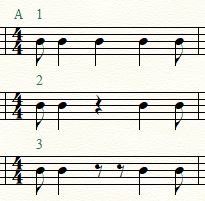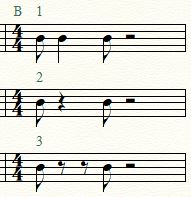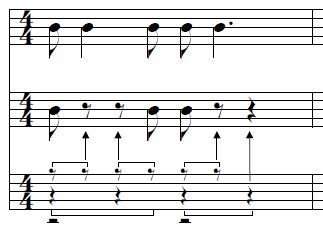Page 1 of 6
how to show dotted rest
Posted: 24 May 2022, 08:11
by DePaule
Should I show the dotted rest like the example above or without the dot like the example below?
![2022-05-24 10_09_18-~_Downloads_131.ly [geändert] – Frescobaldi.png](./download/file.php?id=3485&sid=f638a12a61c73824608df153d9776e70)
- 2022-05-24 10_09_18-~_Downloads_131.ly [geändert] – Frescobaldi.png (4.52 KiB) Viewed 5784 times
Thank you!
Re: how to show dotted rest
Posted: 24 May 2022, 08:51
by David Ward
If that's in 4/4 definitely the upper.
Re: how to show dotted rest
Posted: 24 May 2022, 09:24
by DePaule
It ist 4/4
Re: how to show dotted rest
Posted: 24 May 2022, 19:41
by DePaule
David Ward wrote: ↑24 May 2022, 08:51
If that's in 4/4 definitely the upper.
what is with this example. Should i use the upper or the lower rest?
![2022-05-24 21_39_34-~_Downloads_131(3).ly [geändert] – Frescobaldi.png](./download/file.php?id=3486&sid=f638a12a61c73824608df153d9776e70)
- 2022-05-24 21_39_34-~_Downloads_131(3).ly [geändert] – Frescobaldi.png (5.48 KiB) Viewed 5749 times
Re: how to show dotted rest
Posted: 25 May 2022, 09:52
by David Ward
Again, definitely the upper.
Re: how to show dotted rest
Posted: 25 May 2022, 12:47
by John Ruggero
The rule is that the two halves of a 4/4 or 2/2 measure should be clearly shown. Exceptions are made for simple rhythms like
dotted-half/quarter or quarter/half-note (not rest)/quarter. Some make an exception for simple syncopations like eighth/quarter/quarter/quarter/eighth. Others do not and would tie the middle quarter note.
A counter example would be eighth/dotted-half/eighth. This kind of rhythm is difficult at first sight without a second voice to orient it. One would divide the dotted-half into two dotted-quarters to show the two halves of the measure.
Re: how to show dotted rest
Posted: 26 May 2022, 18:45
by Anders Hedelin
Interestingly enough notes and rests don't seem to demand the same level of rhythmic clarity.
In both examples below the notes on the first staff are unproblematic, but the rests on the second ones are not.

- Notes vs. rests 1.JPG (18.33 KiB) Viewed 5635 times

- Notes vs. rests 2.JPG (16.54 KiB) Viewed 5635 times
The rule of showing the middle of a 4/4 measure is broken in A1 as well as in A2, but acceptable with notes, and with notes only (A1) – not with a rest (A2).
The division of the quarter rest into two eighth rests is needed also in B (as in B3), despite its not being placed round the middle of the measure. It seems that rests need to demonstrate the beats of the meter more than notes.
Edit: The easier way to put this is that notes may be syncopated, rests not.
Re: how to show dotted rest
Posted: 27 May 2022, 02:00
by John Ruggero
Anders Hedelin wrote: ↑26 May 2022, 18:45
The easier way to put this is that notes may be syncopated, rests not.
That sums it up nicely! Anyone have an explanation of why?
Re: how to show dotted rest
Posted: 28 May 2022, 06:25
by Anders Hedelin
John Ruggero wrote: ↑27 May 2022, 02:00
Anyone have an explanation of why?
FWIW this is an attempt at an explanation:
It strikes me that notes and rests belong in different structural levels, at least partly so. Notes generally are part of the rhythmic details on the structural surface (1st staff below).
Rests have, however, a double function and can be part of the same surface, as well as of a more fundamental rhythmic structure, the 'metric grid', so to speak (3rd staff).
An image could be that the 'grid' is hidden, and just understood, when the measure is filled with notes, but showing when there are gaps between the notes = rests. You could perhaps compare with when a painter leaves parts of the canvas unpainted, to let its grid of fibres shine through.
The function of this 'metric grid' is to make clear where we are in the meter. This rules out syncopation, which is a kind of 'teasing the meter'. At least traditionally, the metric grid doesn't tease itself, i.e. rests are not syncopated (2nd staff).

- Metric grid.JPG (24.04 KiB) Viewed 5585 times
I wonder if Schenker ever wrote about this?
Re: how to show dotted rest
Posted: 28 May 2022, 12:36
by John Ruggero
Brilliant reasoning. That sounds right to me, Anders. In other words, rests represent the silence, the substratum, upon which sounds are placed in time and this silence must be represented without the surface discontinuities like syncopation that work against this substratum. Did I get that right?
I am not aware of Schenker having addressed this issue of rhythmic notation. There is a section of rhythm and meter in Der Freie Satz that I mentioned once, but I don't see anything about this there.